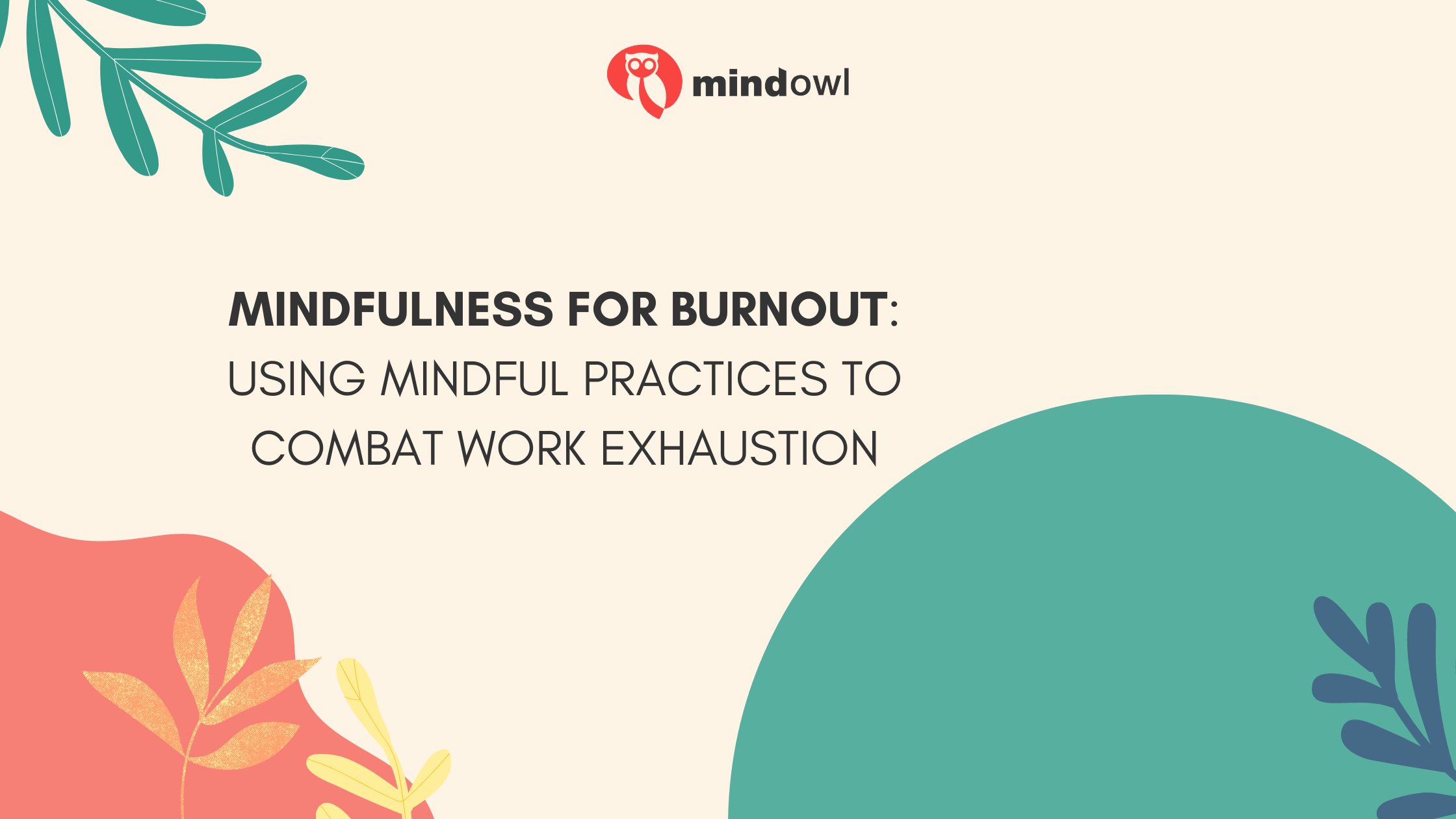Feeling tired after a long day at work is normal. But what if that tiredness turns into something more? This is where we talk about burnout, a state of mental and physical exhaustion caused by prolonged stress at your job.
It’s like running out of fuel during a marathon – you know you need to keep going, but just can’t find the energy.
Mindfulness might be the answer here. Research shows mindfulness can help reduce stress and prevent burnout by helping us pay more attention to our thoughts and feelings without getting overwhelmed by them.
In this article, we’ll guide you through mindful practices to tackle work exhaustion head-on. From daily exercises to creating a supportive environment at your workplace, we’ve got it covered.
Key Takeaways
- Mindfulness can reduce work stress and prevent burnout by helping us focus on the present moment.
- Incorporating simple mindfulness exercises into daily routines, like mindful breathing or keeping a gratitude journal, can greatly relieve feelings of exhaustion at work.
- Creating a mindful workplace environment through things like natural lighting, comfy settings, and regular mindfulness training can boost overall employee well-being and productivity.
- Research shows that practising mindfulness regularly leads to better concentration, less anxiety, and higher job satisfaction among professionals across various sectors.
- By recognising early signs of burnout such as constant tiredness or feeling overwhelmed by tasks, we can use mindfulness techniques to address these issues before they become more serious problems.

Understanding Burnout
Signs and Symptoms of Burnout
Burnout sneaks up on you, draining your energy and making every day at work feel like a mountain to climb. This sneaky thief of motivation affects not just your job performance but also how you feel outside of work.
- Physical exhaustion – You’re always tired, no matter how much you sleep. It feels like you’re running on empty, struggling to get through the day.
- Emotional distance from work activities – Tasks that once sparked joy now leave you feeling numb. You start to detach from your projects and colleagues.
- Reduced performance at work – Your ability to concentrate plummets, and so does your productivity. Deadlines are missed, and the quality of your work suffers.
- Feeling irritable or impatient with co-workers – Small annoyances become big grievances. You find it hard to keep your temper in check.
- Lack of satisfaction from achievements – The victories that used to make you proud now barely catch your notice. You question if your efforts are worth it.
- Withdrawal from social situations – Catching up with friends or attending social gatherings doesn’t appeal to you anymore. You’d rather be alone.
- Sleep disturbances – Either you can’t sleep or you sleep too much. Restful sleep seems like a distant memory.
- Headaches and muscle pain without a clear cause – Mysterious aches appear, making it even harder to face the day.
- The constant feeling of being overwhelmed – Every task feels insurmountable, like climbing Everest in flip-flops.
Identifying these signs early is vital for tackling burnout before it leads down a slippery slope towards more severe mental health issues such as depression and anxiety.
Common Causes of Work Exhaustion
Work exhaustion doesn’t just pop up out of nowhere. It builds up over time because of many factors at our jobs. Here’s what often causes this tired feeling:
- Long Hours: Spending too much time at work, especially during the COVID-19 pandemic, has pushed many health professionals to their limits.
- High Stress Levels: Jobs that keep you on your toes without a break can lead to major stress. Think about teachers or social workers who deal with big problems daily.
- Lack of Support: Feeling like you’re in it alone can be tough. Health care workers and caregivers often face this challenge when they can’t get the help they need.
- Unrealistic Job Expectations: Sometimes, bosses expect too much. This can happen in any job, making folks feel like they can never do enough.
- Poor Work-Life Balance: Taking work home or thinking about it all the time means you never really switch off. This is a big problem for people in high-pressure jobs.
- Emotional Drain from Helping Others: Jobs that involve looking after people, like nurses or psychotherapists, can make those workers feel empty inside.
- Lack of Recognition: Not getting credit for hard work is disheartening and makes going to work feel pointless.
- Changes in Work Routines or Roles: Big changes at work are stressful. This has been especially true with shifts brought on by the COVID-19 pandemic affecting everyone from federal government employees to hospital staff.
- Feeling Stuck in Your Job Position: When there’s no room to grow or learn new things, it’s easy to lose interest and feel trapped.
- The volume and complexity of information: thanks to emails and online tools — have skyrocketed, overwhelming many workers across different sectors.
Each of these factors chips away at a person’s well-being over time, leading them down the path towards burnout if not addressed properly through practices like mindfulness exercises and seeking social support when needed.

The Role of Mindfulness in Preventing Burnout
Core Principles of Mindfulness
At the heart of mindfulness lies the practice of paying attention to the present moment with an open, curious mind. This approach helps us notice our thoughts, feelings, and surroundings without harsh judgement or criticism.
Living in the now becomes easier as we train our minds through meditation and other exercises to accept what is happening around us.
Mindfulness involves meditation encouraging awareness of the generous present without judgment.
Another key principle is non-attachment to outcomes; this means not getting too caught up in what might happen next or dwelling on past events. Instead, focusing on being truly present can help decrease stress and increase contentment.
Research including neuroimaging studies shows that mindfulness positively changes our brain and behaviour, leading to improved well-being. Mindfulness-Based Stress Reduction (MBSR) and Mindfulness-Based Cognitive Therapy (MBCT) offer structured ways for people to learn how to integrate these principles into their daily lives, reducing symptoms of stress, anxiety, and even major depressive disorder.
How Mindfulness Alters Perception of Stress
Mindfulness changes how we see stress. Instead of viewing it as a huge, unmanageable threat, mindfulness teaches us to approach stress with curiosity and openness. This shift in perspective is significant.
It transforms our reactions to stressful situations from automatic responses to thoughtful actions. Mindfulness-based interventions (MBIs) have a big impact on reducing stress right after they’re introduced and even three months later.
Using MBIs, like short meditations or mindful breathing practices, helps us focus on the here and now. This attention to the present moment reduces feelings of anxiety and depression often linked with job burnout among health professionals and others under constant pressure at work.
Studies show that nurses who practice mindfulness experience less depression, anxiety, and stress. This not only makes daily stresses more manageable but also improves overall well-being by changing our approach to life’s challenges.
Practical Mindfulness Techniques to Combat Burnout
Daily Mindfulness Exercises
Mindfulness exercises are simple ways to calm your mind and reduce stress. They help you stay present and aware of your thoughts and surroundings. Here’s how you can incorporate mindfulness into your daily routine:
- Start Your Day with a Mindful Breathing Session: Spend five minutes each morning focusing only on your breath. Inhale slowly, then exhale even more slowly. This helps set a calm tone for the day.
- Take Mindful Walks: Instead of rushing from point A to B, use walking as a chance to notice things around you. Pay attention to the feel of the ground under your feet, the sounds in the environment, and the air on your skin.
- Practice Mindful Eating: Turn meals into an opportunity to truly experience your food. Notice the colours, smells, textures, and tastes of what you eat. Eat slowly, savouring each bite.
- Use Short Meditation Breaks: Throughout the day, pause for three-minute meditations. Focus on your breath or do a body scan from head to toe, noticing any sensations or feelings without judgement.
- Keep a Gratitude Journal: Each evening, write down three things you’re grateful for. Focusing on positive aspects of your life increases awareness and contentment.
- Do Single-Tasking: Whenever possible, focus on doing just one thing at a time. Whether it’s writing an email or drinking a cup of tea, give it your full attention.
- Engage in Mindful Listening: When talking to others, listen with full attention without planning what you’re going to say next. Notice their expressions and tone of voice.
- Mindful Breathing Before Sleep: End your day as it began – with mindful breathing. It will help clear your mind and prepare you for restful sleep.
Incorporating these exercises into your daily routine can greatly impact mindfulness and reduce burnout over time. Just remember that consistency is key – aim to make these practices regular parts of your day for about six months to truly feel their benefits.
Mindful Breathing Practices
Feeling worn out from work is common, but there’s a powerful tool that can help. Mindful breathing practices bring calm and focus, reducing stress at its root. Here’s how to start:
- Set aside a few minutes each day specifically to focus on your breath. This can be first thing in the morning or during breaks at work.
- Find a comfortable position in a quiet space. Sit with your back straight but not stiff. Rest your hands loosely on your lap.
- Close your eyes gently. This helps block out distractions and centres you on the exercise.
- Take notice of your breath without trying to change it at first. Feel where the sensations are strongest, perhaps in your nose or your stomach.
- Notice when your mind wanders—which it will—and gently redirect it back to the sensation of breathing without judgment this shifts perception towards stress, making challenges seem more manageable.
- Varying the practice by incorporating deep abdominal breathing strengthens emotional resilience against stress triggers found in high-pressure jobs.
- End each session by gradually bringing awareness back to the room, noticing any sounds around you before opening your eyes; take a moment to appreciate the calmness you’ve cultivated, reinforcing positive behaviour towards managing work-related stress effectively.
These steps provide a practical framework for integrating mindful breathing techniques into everyday life, effectively combating burnout while enhancing overall professional well-being by increasing mindfulness and reducing feelings of depression or anger associated with chronic stress conditions often found in demanding careers like healthcare or education sectors across countries like the United Kingdom.
Implementing Mindfulness in the Workplace
Creating a Mindful Work Environment
To create a mindful work environment, consider the following:
- Incorporate natural elements such as indoor plants, natural light, and green spaces to reduce stress and fatigue among employees.
- Design and organise workspaces with ergonomic furniture and comfortable settings to promote physical well-being and enhance work performance.
- Encourage regular breaks through designated relaxation areas or quiet zones where employees can practise mindfulness exercises or simply unwind.
- Foster open communication and cultivate a supportive workplace culture where employees feel comfortable discussing their mental health and seeking help when needed.
- Offer mindfulness training sessions or workshops to educate employees on the benefits of mindfulness practices and provide them with tools for managing stress effectively.
- Implement flexible work arrangements that accommodate individual preferences for productivity, rest, and personal well-being, supporting a healthy work-life balance.
- Establish clear boundaries around after-hours communication to prevent burnout from excessive digital connectivity outside of working hours.
- Create opportunities for social connection through team-building activities, group meditation sessions, or wellness programmes that promote a sense of community within the workplace.
By considering these strategies, organisations can create an environment that promotes mindfulness, reduces burnout, and enhances overall employee well-being.
Mindfulness Training for Teams
Mindfulness training for teams, facilitated by experienced mindfulness tutors, is essential in combating work burnout and fostering a healthier work environment. Here are some key steps to successfully implement mindfulness training for teams:
- Educate the team about the benefits of mindfulness by explaining how it can reduce stress, enhance focus, and improve overall well-being.
- Introduce practical techniques such as mindful breathing exercises, guided meditation sessions, and daily mindfulness practices to the team members.
- Encourage open communication about stress and burnout within the team to create a supportive and understanding environment.
- Incorporate mindfulness into team meetings by starting with a brief mindfulness exercise to promote relaxation and focus.
- Provide access to resources such as mindfulness apps, articles, or workshops to further support the team’s mindfulness journey.
- Lead by example as a manager or leader by practising mindfulness and openly advocating its benefits within the workplace.
- Offer regular check-ins to gauge the effectiveness of the mindfulness training and provide ongoing support for any challenges or concerns that may arise.
Implementing these steps will help create a culture of mindfulness within the team, promoting resilience against burnout and supporting overall well-being in the workplace.
Conclusion
In conclusion, mindfulness offers effective strategies for combating work exhaustion and burnout. By incorporating daily mindfulness exercises and practising mindful breathing, individuals can enhance their emotional resilience and focus.
Implementing mindfulness in the workplace through training programs can create a more mindful work environment, leading to improved well-being for professionals. The benefits of mindfulness go beyond reducing burnout; they also positively impact overall mental health and job satisfaction.
Mindfulness not only helps prevent burnout but also improves professional well-being by promoting enhanced focus and efficiency while combatting stress. Integrating these practical techniques into daily routines is essential for natural and effective practice.
Seeking support from therapists or coaches can further aid in learning and implementing successful mindfulness techniques to combat burnout effectively.
MindOwl Founder – My own struggles in life have led me to this path of understanding the human condition. I graduated with a bachelor’s degree in philosophy before completing a master’s degree in psychology at Regent’s University London. I then completed a postgraduate diploma in philosophical counselling before being trained in ACT (Acceptance and commitment therapy).
I’ve spent the last eight years studying the encounter of meditative practices with modern psychology.

